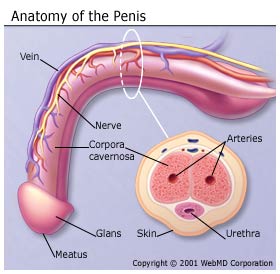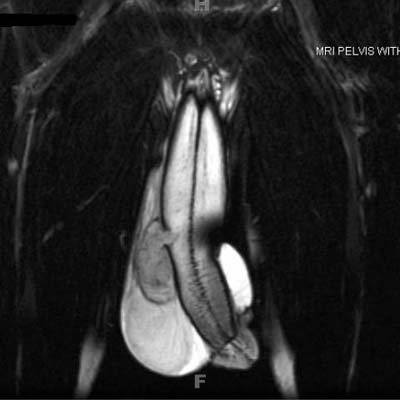So, what actually breaks in a penile fracture? Essentially, the shaft of the penis is like a sponge. There is tissue called the copora cavernosa (or corpus spongiosum), which is above the urethra. This tissue takes up most of the bulk inside the shaft. It runs from the pubic bone down to the end of the penis. When arousal occurs, the structure of the copora cavernosa allow the penis to become gorged with blood. There is a firmer, denser tissue on the outside of the spongy tissue (if looking at the diagram, you'll see it as the white "wall" in the cross-section). Thus, when the spongiosum is filled, the penis becomes hard (otherwise, without this denser tissue surrounding it, the penis would be a floppy sponge).
Image by WebMD
So, this denser tissue, a fibrous envelope for the spongy tissue, is a defender against trauma to the penis. However, it is not invincible and can be overtaken. When a fracture occurs, the envelope of tissue surrounding the spongiosum is the first to be damaged. Then, depending on the extent of the trauma, the fracture can go deeper. In more extreme circumstances, the fracture can damage the network of veins surrounding the penis, as well as the urethra.
While embarrassing, note that any suspected penile fractures must be treated as a medical emergency. Time is very important when dealing with a penile fracture. The quicker the damage is assessed, the quicker the treatment, and the higher the chance for a full recovery.
This is not something that will go away. The fracture can damage some of the veins that regulate the blood flow to the penis. This, coupled with swelling, will cause the penis to have an exaggerated curve, usually (but not always) on the side opposite the trauma. For example, if the side that receives the trauma is on the left, the penis will curve to the right. This is because the damaged area will swell and bruise. If untreated, the exaggerated curve, as well as impotence, could be permanent. This is, again, why time is a very important factor when seeking treatment.
This is also considering a better case scenario. This is assuming the urethra, the pathway from the bladder to the end of the penis that allows urination, is not injured. If the urethra is damaged, more symptoms may be present. Breaks to this point are likely to have bleeding. A cardinal rule to always remember about penises is: only two things should come out of a penis: semen and urine. Anything else is abnormal. The reason you may see blood is because the spongy tissue responsible for erections has been compromised, so the blood will leak. If the urethra is also damaged, the blood will flow out.






What a professionally written article, Mwar! I'm glad to see the topic addressed in such an easily accessible way and with a little humor thrown in. I can't wait to read the rest of your articles, good job!
This is a wonderfully written article. You did a great job getting your facts straight and adding a touch of humor to such a scary topic.
Very well written! All I can say is OUCH.